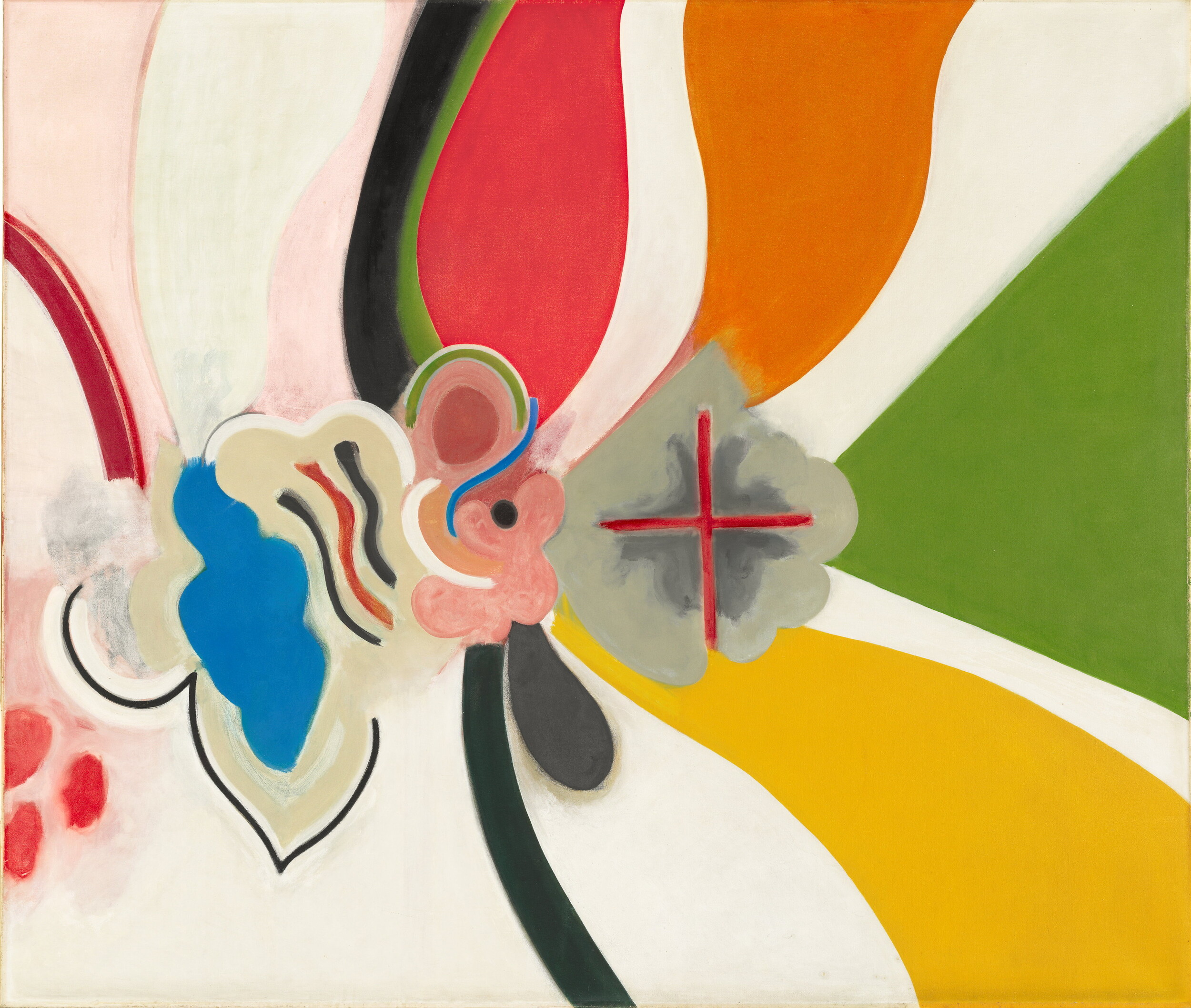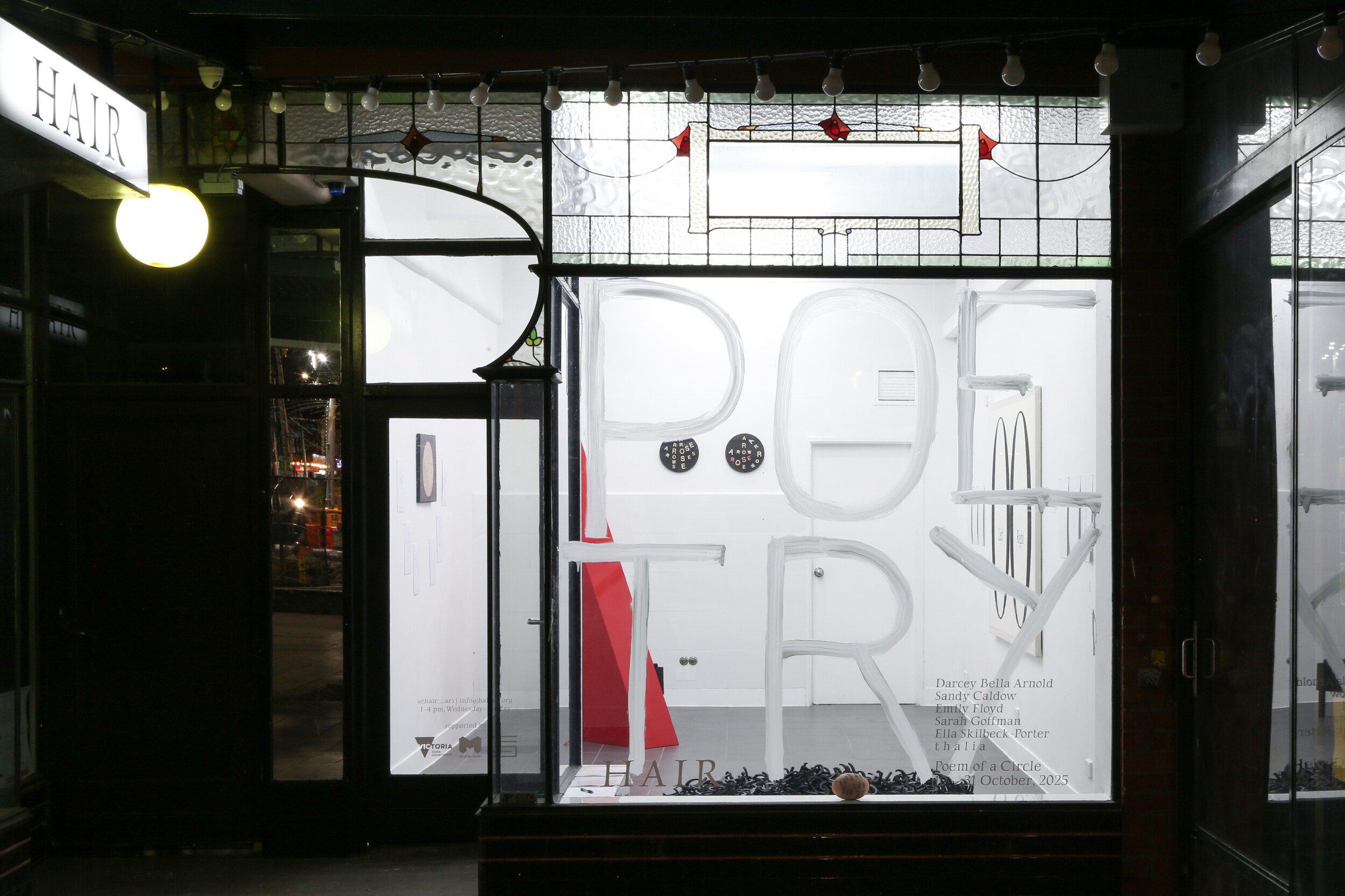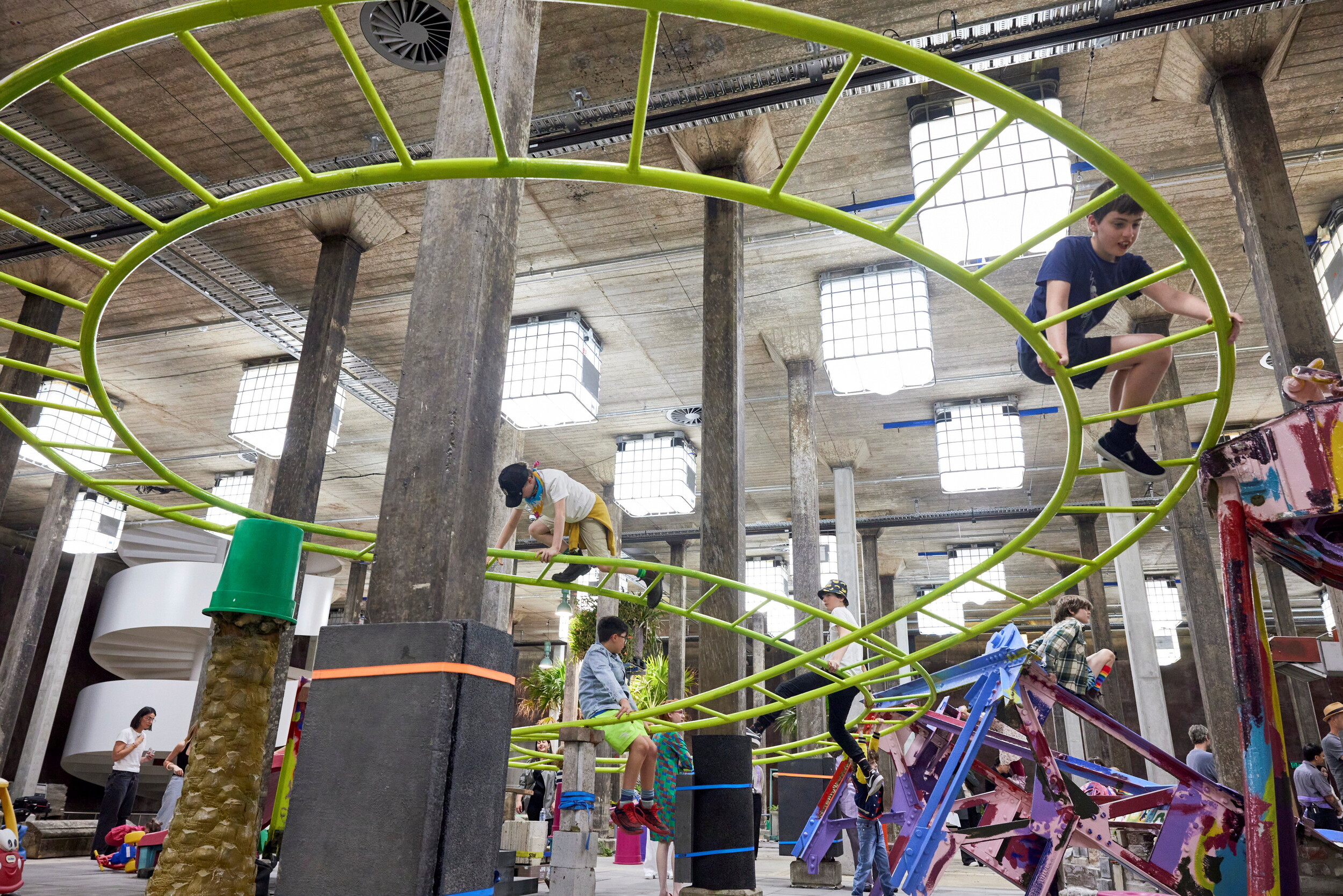Andrea Illés, no rock no flower, evolutive durational performance, West Space, 2025. Photograph by Janelle Low.
no rock, no flower
Declan Fry
Surveillance Tapes
I enter West Space to see Andrea Illés no rock no flower. The video screen hanging at the entrance shows me enter. It shows me watch myself enter, shows me watch others who are not watching me enter, shows them watching the screen showing me watching me watching them watching me enter. It shows me all of this from four different angles.
Later, Andrea gives me her angle. It’s an odd sensation, she says, being photographed or shown from behind. Having your body shown to you in unexpected ways. You have to reconcile yourself to this strangeness, or reconcile the strangeness within yourself.
Inside the room, a member of the audience rests their arm on several sets of mattress springs. Originally these were covered in fabric; now only the skeletons remain. A week and a half into the show, Andrea took a pair of scissors, skinned them all. The mattresses sit multiplied, like the video screens’ doubling of ourselves and the room we are in. I check the four-channel screen again, searching for myself, relieved to find I am not there.
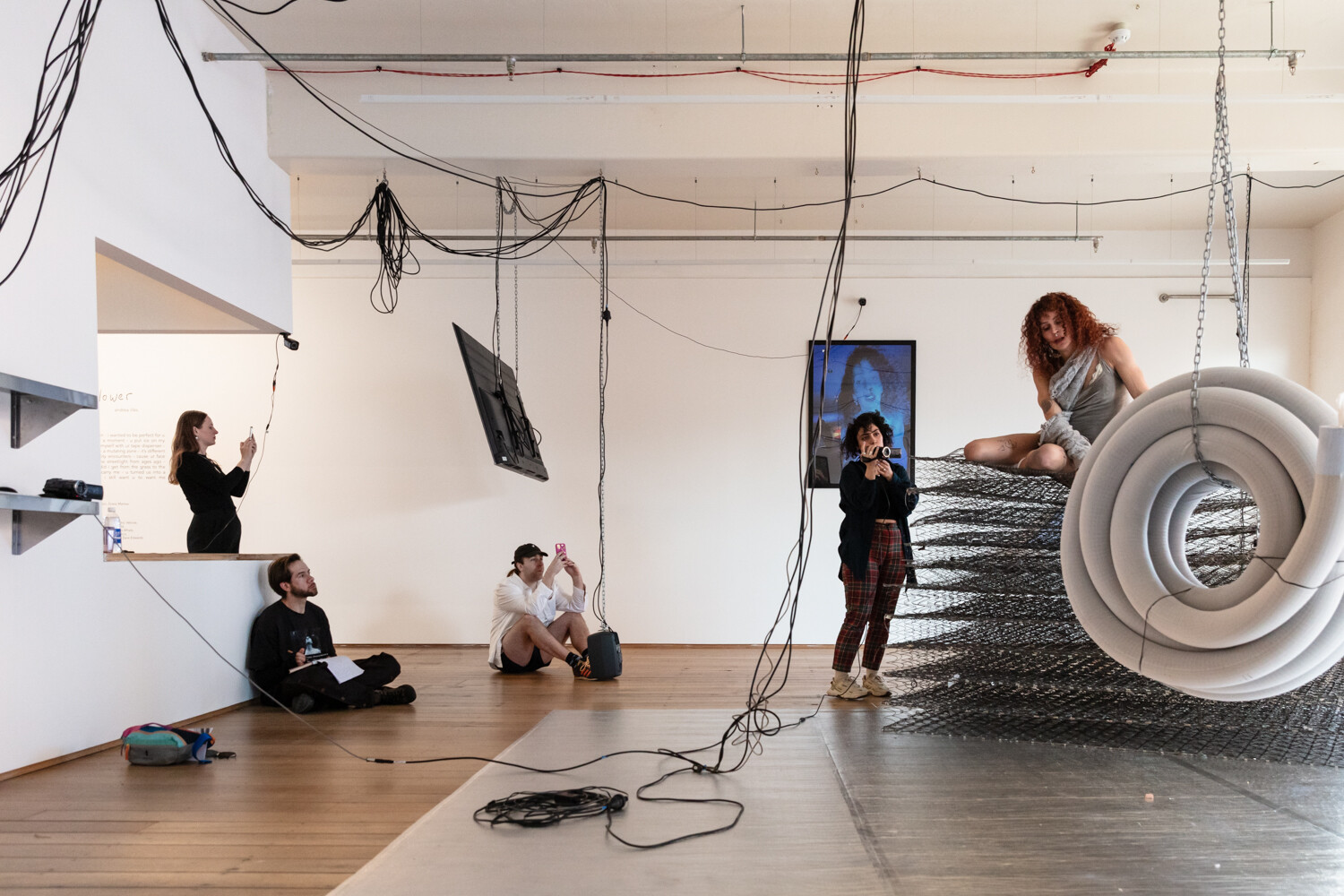
Andrea Illés, no rock no flower, durational performance, West Space, 2025. Photograph by Janelle Low.
To begin the second phase of her durational performance, Andrea runs, throws her body across the coiled tube hanging in the middle of the room, draping herself across its length. A photographer, documenting the performance, gets down to her level, body eased against the boards, takes a shot.
That’s when Andrea falls.
It feels sudden. Unintended. Has she had an accident? Is she OK? I look up from my notepad. I see Andrea looking at me. Picture a face at the corner of your eye. This face is smiling. It’s a rictus smile. If you picture this face very intensely, the way I am picturing it now, maybe you will be forgiven for feeling what I felt.
I’m watching you. I can see you.
Her knuckles scrape the floor as she stands and her eyes flutter and then she looks up, ecstatic, before dropping again, repeatedly: first on her back, then upon her front, until each feels reversible.
A remixed loop of the chorus of Ariana Grande’s ‘Breathin’ plays in the background. As Andrea spasms, Grande sings, like someone caught in a trance, like someone who’s not quite herself.
Breathe, she sings. Just keep breathing, keep breathing.
Later, Andrea tells me her work is about failure. In this, it is very successful. I believe in the failure. (Did she mean to fall this time? Is she hurt?) Each time I believe, I take failure at its word, unable to see that each fall Andrea accomplishes requires intention, agency. Her choice.
Transformations
Before it became a curse, connection offered promise. Picture those scuzzy Y2K liberation narratives extolling the promises of the web. Who will you connect with today? they asked. The reply felt magical, utopian: Why not everyone?
I am conscious there are only five or six of us in the room as the second phase of no rock no flower begins. This intensifies our sense of connection.
When Andrea takes one of the cameras propped upon the mattress springs and hands it to Aida, an audience member I just met, I assume that Aida must be involved in some way. That they have been clued in on what to do. Often in her performances, Andrea will give a camera to those watching her. And what was the promise of online intimacy, if not a camera in everyone’s hand?
Aida tells me afterward she first saw Andrea performing on Twitch. Later, watching the grainy digital video of Andrea’s Twitch channel, I think of earlier digital mediations of life, those mundane horrors captured fly on the wall, as if via surveillance: Hideaki Anno’s roving camcorder eye in Love & Pop (1998); Asia Argento taking up a camera of her own in Scarlet Diva (2000); the fuzzy electricity of Virginie Despentes and Coralie Trinh Thi’s Baise-moi (2000); Hayato Ichihara pining for their idol in Shunji Iwai’s All About Lily Chou-Chou (2001). Jennifer Ringley’s JenniCam website (1996-2003), part proto-livestream, part performance art. “Lifecasting”, Ringley called it.
Unlike those examples, those of us now watching Andrea are granted immediacy. But we are also isolated. I find myself glancing up at the large four-channel installed at the entrance; it’s hard to look away. Strange, how compelling the representation is, compared to the reality. Especially as trans visibility has gone “mainstream”, I sometimes think of Foucault. Visibility is a trap! You can see Pose (2018), you can see I Am Jazz (2015), you can see Yasmin Finney and Elliot Page. Texte zur Kunst devoted their March 2023 issue to trans perspectives. Yet the hope that visibility might offer opportunities to combat violence or precarity is fraught, too. As aspects of a represented identity become codified, they risk being transformed into something simpler. A series of digestible or familiar narratives and shorthand. Like forms of surveillance that record indiscriminately, bringing everything into their gaze, to stop paying attention to particularity risks not paying attention at all.
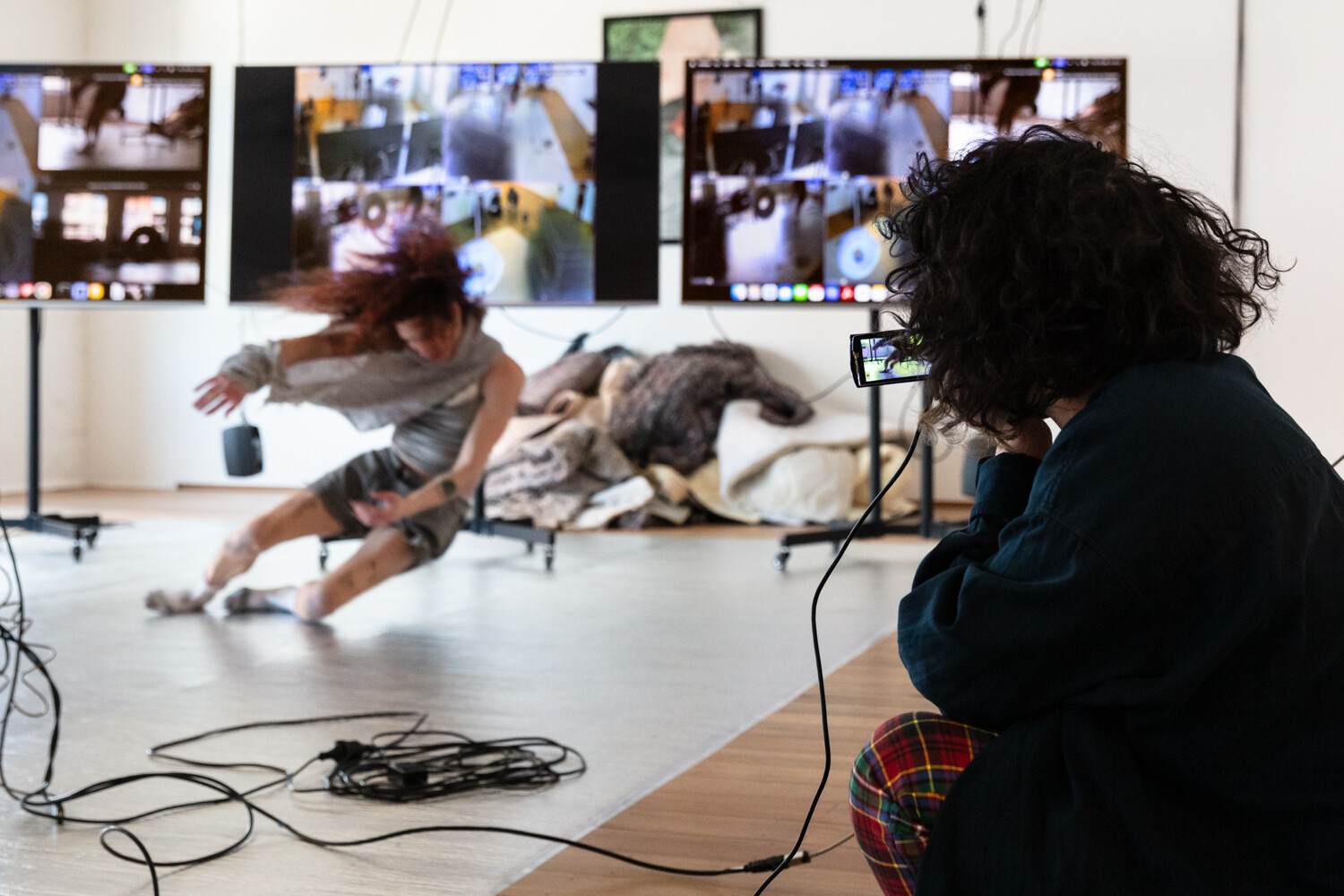
Andrea Illés, no rock no flower, durational performance, West Space, 2025. Photograph by Janelle Low.
Andrea’s contorted body enacts its own surveillance. How far can I bend this thing I am? What can I invite myself to perform?
When Andrea tumbles, when she arches backward, it looks like it would hurt. Only it doesn’t hurt—she’s choosing it. She’s most in control when enacting the appearance or illusion of its loss.
If this seems like a troubling thought, I think we should stay with this trouble a little. Fall with it, see what comes out. Intensifying her pleasure by surrounding herself with its replication, Andrea reminds me of the narrator in Belgian novelist Amélie Nothomb’s Fear and Trembling (1999), a woman who recalls, as a child, eating food she loves in front of a mirror, watching herself enjoying it, heightening the pleasure of everything she feeds upon.
Philosophy of the Bed
Introducing her three-channel digital film Dreem2 (2025), Andrea tells us she is inviting us into her bed. She’s not joking. Much of Dreem2 is like moving through a space that is intensely private yet shared. It captures the feeling of being awake while others are asleep, or of being between places, neither quite waking nor sleeping.
Andrea and I talk after the show about how denying something can acknowledge it. How the dual impulse is often also a duelling impulse. This is the philosophy of the bed. Arguably its most famous philosopher is A Nightmare on Elm Street’s Freddy Krueger, although the bedroom is the real star of the series. The kids tell themselves: don’t fall asleep. Basic Freudian psychology tells us: fall asleep. Negation becomes invocation. Freddy dies, Freddy lives. (The title, and promotional tagline, of the fifth and final Nightmare says it all: Freddy’s Dead! As if that were possible.) You desire the thing that hurts you, even if it hurts you. The more you try to look away, the closer Freddy gets.
Final Girls
When Andrea was rehearsing for Dark Mofo, she and her collaborator regularly watched Drew Barrymore’s performance in Scream (1996). We were mesmerised by the power of her non-verbal language, she says. The phone receiver cradled in Drew Barrymore’s arm. The politely anxious sighs and laughter as she humours the guy calling her. The knife she plays with.
Andrea adds: Only I hate the way the final girl’s power is based upon being the final girl.
I nod. What kind of power is it anyway, being someone’s prey? Why tie the final girl’s power to finality, to becoming someone else’s culmination point?

Andrea Illés, Dreem2, 2025, still from three channel moving image, 60 min.
I notice, watching Dreem2, how the pleasure of spectatorship is heightened by seeing others react. I find myself watching other audience members watching the film. I begin unconsciously mimicking them. I smile when they smile. I see a person who looks like they’re falling asleep and wonder if I, too, need sleep, why not, it’s after four pm, who wouldn’t want a nap.
Freddy’s children all become bedroom philosophers eventually. The second Nightmare film, with its implicit homosociality (boys rolling in the dirt during sports practice) and explicit homoeroticism (He’s inside me!, the protagonist, Mark Patton—a final girl in boy’s clothes, a boy passing as a final girl?—says of Freddy), explicitly plays with this idea.
Later, I will laugh and tell Andrea I wasn’t sure about including this detail—I didn’t want to give the impression the film was boring, I say—and it’s not true, anyway. There’s a distinction to be made between sleep induced by boredom and sleep induced by rhythm. Some films make you want to fall asleep because of their trancelike qualities. (My Achilles heel is Olivier Assayas, especially Clouds of Sils Maria (2014); I’ve never managed to finish it, my eyes start drooping like Kristen Stewart’s the moment it begins.) The meditative feel of a film like Dreem2 reminds me of how Chantal Akerman described her style. Holding the shot, maintaining a steady gaze, she criticised the Hollywood approach of constant events as a lost opportunity. She wanted, she says, her audience to feel time passing.
Like Freddy, Akerman relished the power she had over others’ lives.
Unlike Freddy, she only wanted two hours.
Andrea is even nicer: she just asks us for one.
Suzanne Ciani goes on Letterman
Much of Dreem2 seems to take place around 3am. Many scenes occur in liminal, non-descript urban spaces whose atmosphere of quiet and safety feels threatened by the possibility of its interruption. Rainy highways. Corporate office parks. Loading zones. Dumpster-filled alleys. Places that feel beautiful to me, Andrea says later, like train tracks after the trains have stopped.
By the end of the film, people are no longer even able to dream. Andrea and her sisters feed upon their dreams, extracting them, going down on the camera’s eye (the POV of the john in their vehicle) and sucking the dreams out through their nose, like hormones extracted through endocrine systems.
The film’s soundtrack ranges from harsh noise and manipulated wind and crow sounds to the pulse of a CMI V synth. At one point, there is a sample of a clarinet lesson. Sometimes you can even hear snippets of the non-verbal sounds in Ariana Grande’s ‘Breathin’.
In one scene, Andrea veils herself in a curtain before crouching, like a midnight phantasm, as Kurt Cobain, voice pitched ominously low, sings ‘Polly’. In another scene, Andrea hangs out with a friend on a mattress while Brian Molko sings Day’s dawning, skin’s crawling, his voice reverberating, slowed to a K-hole pace.
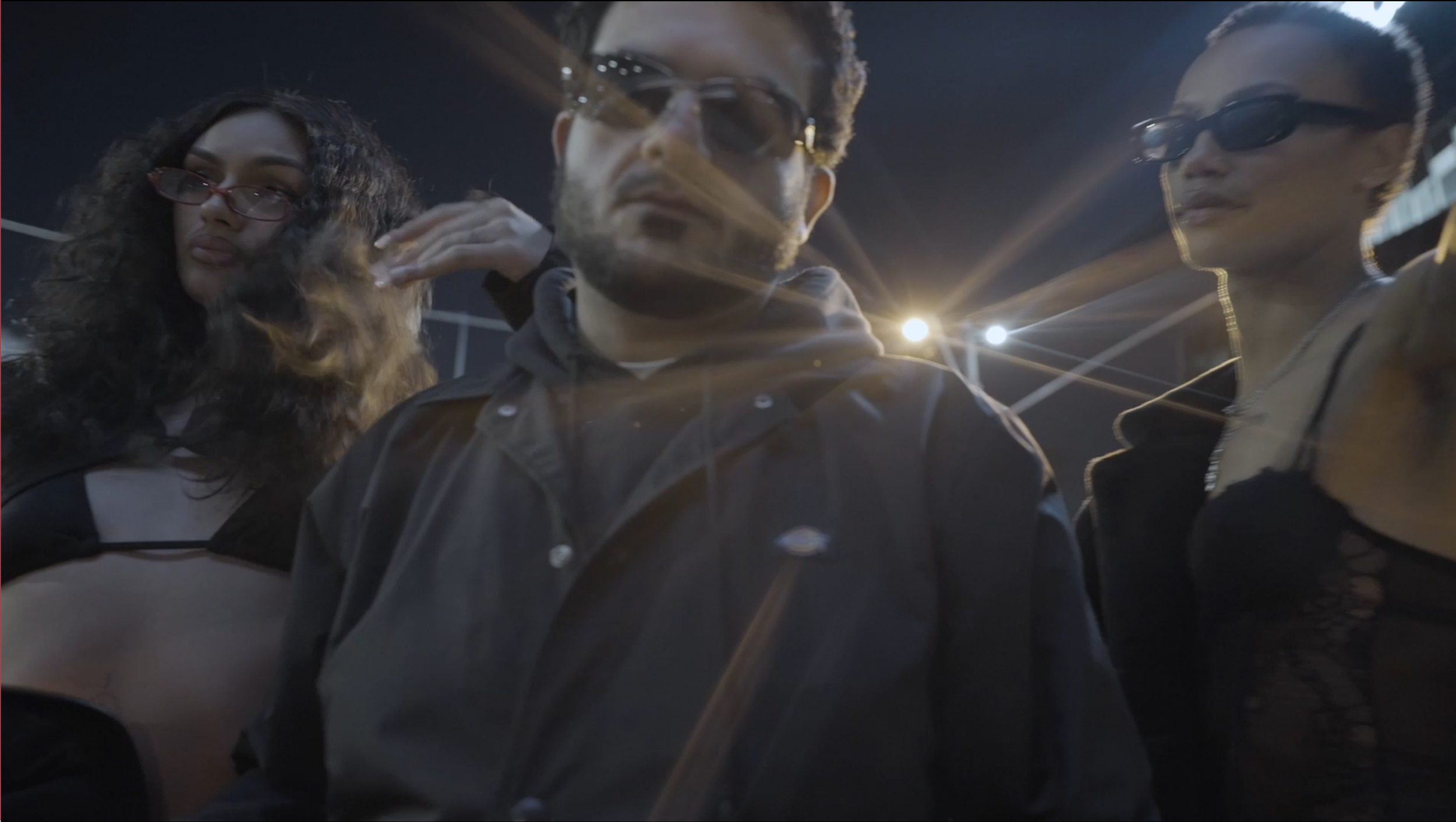
Andrea Illés, Dreem2, 2025, still from three channel moving image, 60 min.
Hearing all of the manipulated vocals, the odd sensation of hearing something from an unfamiliar angle, the strangeness of having someone’s voice shown to you in unexpected ways, I think of Suzanne Ciani’s 1980 appearance on Letterman. After taking Letterman through her Prophet-5 synthesiser, Ciani invites him to try out her vocoder. The audience is amazed. Letterman is speaking like a girl! This makes him visibly uncomfortable. Now it’s her turn. She says, This is my man’s voice, pitch uncannily deep, then, This is my almost male voice. (Which gets a big laugh from the audience.)
Another sound she can make, she says, is a syndrome sound. David says it back: A syndrome sound?
From the moment Letterman begins to speak he is no longer Letterman. He keeps looking around the room for something to grab onto, but there’s nothing there.
Does he want to understand Ciani or her instruments? (Probably not.) The only power he has left, unless he grants her some, is … failure? I want to say failure. As in, the failure to get it.
Only it’s not failure, it’s refusal. Refusal is power, too. By refusing to get it, he reduces her to a joke.
Why do you have this stuff? Letterman asks her eventually. I mean, you don’t go door-to-door saying, I’ll make you sound goofy!
No, she replies. They call me.
Swanston Street
The boldest encapsulation of Dreem2’s bed philosophy occurs during one of its daytime sequences.
Andrea walks down Swanston Street, naked save for a pair of six-inch pink pumps. (After the show she joked, I look tall in those. You were tall, I say. You were about 200cm!)
Call it a radical act of private surveillance or presence. She wants to watch how you watching her makes her feel, watching you.
I’m surprised, though, as the camera follows her down the street, by the relative lack of attention. Barely anyone stops. It’s the middle of the day, there’s quite a few people around, yet hardly anyone bats an eyelid. No one’s concerned? I wonder. Shocked? Titillated? Curious? Even just neutral? Because sometimes surveillance, the gaze, is neutral—like, just notice what’s in front of you, why don’t you?
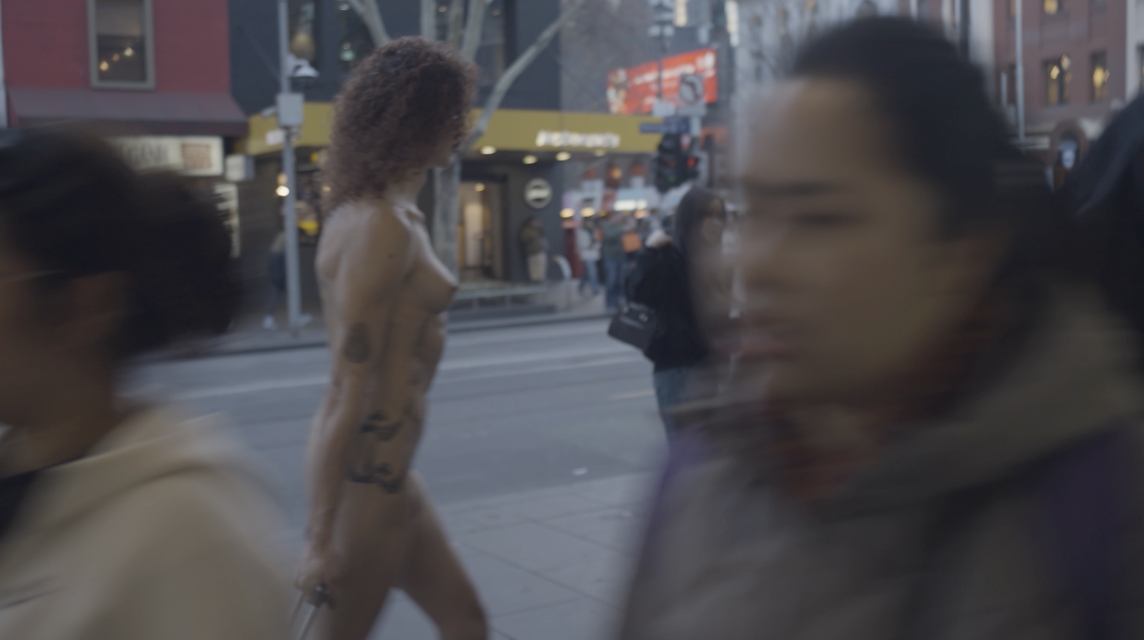
Andrea Illés, Dreem2, 2025, still from three channel moving image, 60 min.
Then I realise it’s the too-conscious refusal to look that is the form of surveillance here. It’s the communal decision to look away that tells you something is there to see. That something is being noticed, perhaps even guarded against. The more you try to look away, the closer Freddy gets.
What Andrea seeks, walking down Swanston Street naked, is this feeling of presence. The kids in A Nightmare on Elm Street tell each other: This is not really happening. Freddy replies: You bet your life it is! You bet your life it is! Oh honey, you bet you li–ife!
This feeling of being overwhelmed is intimately tied to presence. The presence of others, of an audience. I think of all the final girls who escape finality by overcoming their objectification. Overcoming the capture that requires them to be placid or surrender. Instead, they feed upon the idea they should be scared. Like, what would actually happen if I walked down Swanston Street, naked, in pink pumps?
Andrea’s cinematographer, Nelly Clifton, was worried. What should she do, Clifton wondered, if Andrea was attacked? (“Just keep rolling”, she instructed.)
Clifton then asked Andrea if she’d seen American Reflexxx. In Alli Coates’s 2015 short film, the performance artist Signe Pierce, wearing a blue mini-skirt and mirrored mask, walks through the crowded streets of Myrtle Beach in South Carolina. A mob forms. Eventually, one of them assaults her.
Where American Reflexxx is claustrophobic and anxious, Dreem2 shows Melbourne more willing to look the other way. It’s an experiment in which Andrea seems as though she’s choosing to be the subject—and she is—but she’s also the experimenter. Recognising the tension of being perceived, she invites it in.
Here, Andrea draws a distinction between dissociation and disassociation. Dissociation, she says, is something that overtakes or overcomes you. Something you are propelled into. Disassociation is something you choose. Something you will. Like a trance.
The failure, as when Andrea falls, is in being fooled. Misinterpreting a successful pratfall is taking a gesture you do not understand (or do not wish to) and dubbing it unsuccessful. It’s maintaining an authority you haven’t earned.
This provides one way of reading the conclusion of Dreem2. The film ends in ecstasy, everyone dancing atop the john’s vehicle. It’s a vision, Andrea says, of what being free might mean.
To exist, she says, with my sisters.
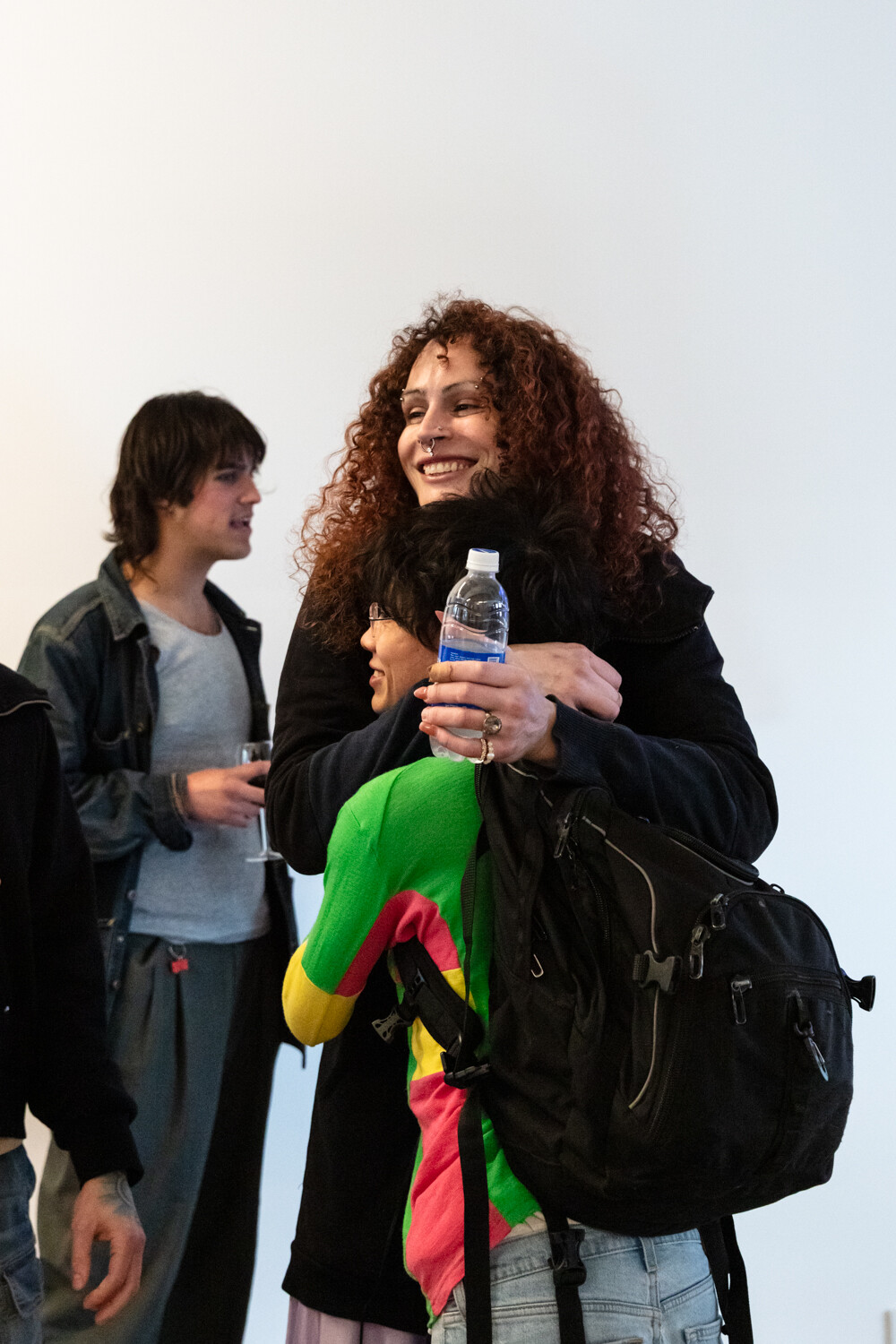
Andrea Illés, no rock no flower, durational performance, West Space, 2025. Photograph by Janelle Low.
Declan Fry is a writer from Naarm/Melbourne
